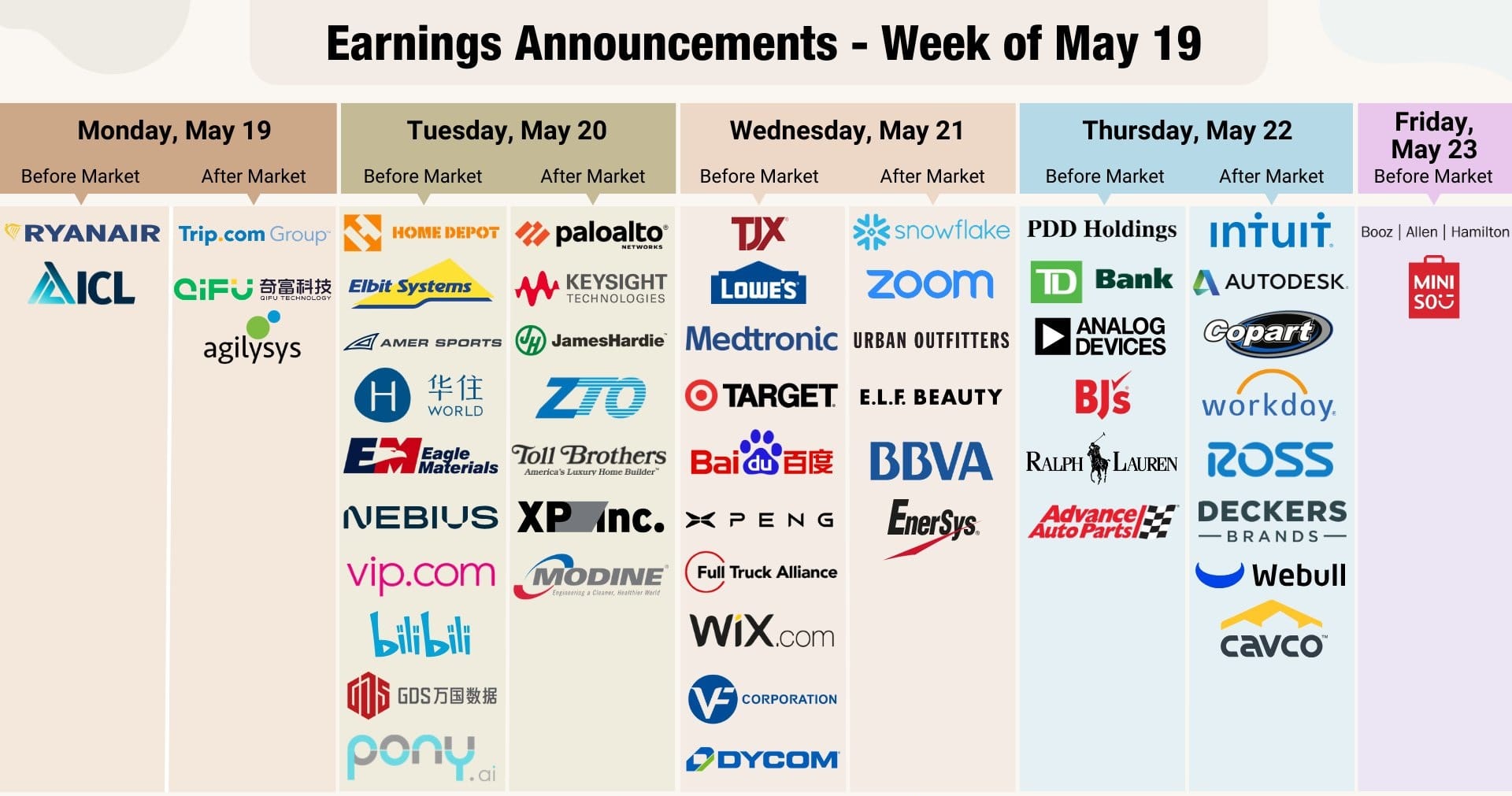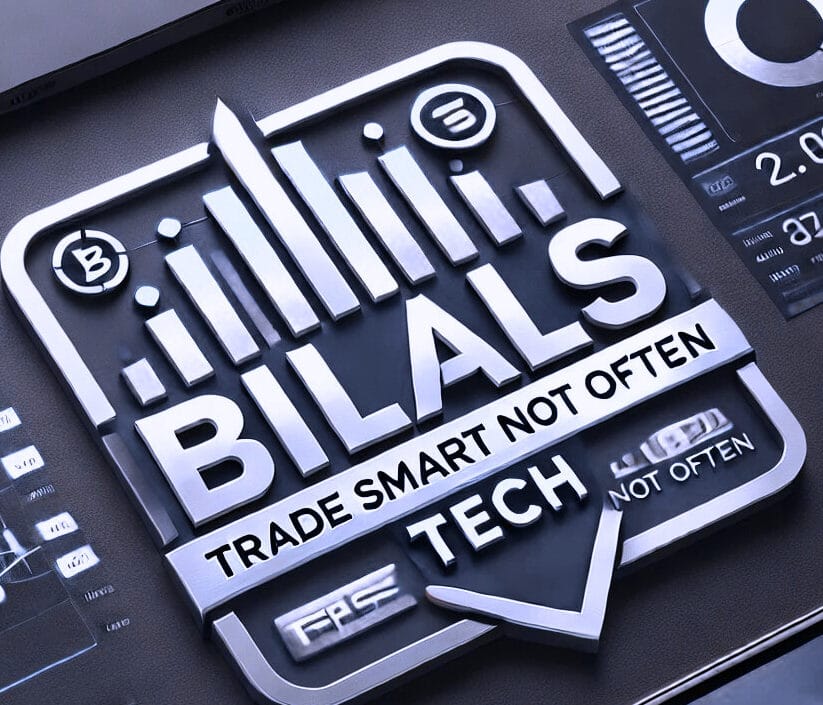Market commotion intensifies as trade tensions, weak data, and earnings shape this week’s volatile financial forecast. Here’s what you need to know.
Nvidia Earnings and Global Central Bank Decisions: Weekly Market Outlook
Nvidia earnings, Fed minutes, and inflation data lead this week’s action. Central banks and OPEC moves may stir volatility in global financial markets.
Daily Market Roundup
Markets Dip on Trump Tariff Shock, Gold Soars, BTC Slips Below $110K
🔹 Markets: Dow -0.61%, S&P -0.67%, Nasdaq -1.00%. Trump’s 50% EU tariff and Apple ultimatum shook sentiment. All major indexes lost over 2.4% on the week.
🔹 Yields & Fed: 10Y at 4.509%, 30Y at 5.031%. Fed officials warn tariffs could fuel inflation, clouding rate path.
🔹 Canada: Retail sales headline beat (+0.8%) but ex-autos missed. BoC rate cut odds fade.
🔹 Commodities: Gold surged to $3,359 (+5% weekly) on safe-haven flows. Oil +0.54% Friday but down for the week. Silver flat at $33. Platinum & palladium spiked.
🔹 Europe/Asia: Germany Q1 GDP revised up to +0.4%. France consumer confidence fell. UK retail sales beat sharply. Japan CPI sticky at 3.6%.
🔹 Crypto: BTC fell below $110K on tariff jitters. XRP up to $2.44, but rising exchange reserves raise red flags. GENIUS Act gains traction; JPMorgan eyes stablecoin. JUP +16% on Solana DeFi news.
Daily Market Roundup
Nasdaq Rises on Tech Strength, BTC Nears New High, XRP ETF Sparks Buzz
🔹 Markets: Dow flat, S&P -0.04%, Nasdaq +0.28% led by PDD, TSLA, GOOGL, and AMZN.
🔹 U.S. Data: KC Fed Index slid to -10. Flash PMIs beat (Mfg & Services both 52.3). Jobless claims steady.
🔹 Rates & Gold: 10Y yield eased to 4.55%. Gold fell to $3,289 as USD strengthened (DXY 99.86).
🔹 Canada: PPI -0.8% m/m; raw material costs fell sharply. BoC at G7 pushed for coordinated tariff dialogue.
🔹 Commodities: Oil -$0.37 to $61.20 on OPEC+ output risk. Silver retreated to $32.95 after 7-week high.
🔹 Europe: DAX -0.5%, CAC -0.7%. Yields dipped, cushioning losses. G7 focused on global trade friction.
🔹 Crypto: BTC near ATH ($111.8K); Strategy to raise $2.1B for more BTC. XRP +25% in OI as first ETF launches on NASDAQ. SUI hit by $220M Cetus hack.
Daily Market Roundup
Stocks Slide as Bond Yields Spike, Bitcoin Hits Record High
🔹 Markets: Dow -1.91%, S&P 500 -1.61%, Nasdaq -1.41%. UNH -5.78% on DOJ probe and leadership turmoil. Broad selling tied to bond market volatility.
🔹 Yields Surge: 10Y at 4.584%, 30Y at 5.079%—highest in months. Weak bond auction, deficit fears fueled the spike.
🔹 Canada: Housing prices fell 0.4% in April. BoC rate cut odds dropped to 31% as yields climbed.
🔹 Commodities: Oil -0.74% to $61.57 on surprise inventory build. Gold held $3,307 on safe-haven demand. Silver rallied to $33.20.
🔹 Europe: DAX hit record; FTSE 100 one session from all-time high. Spain near 2008 levels.
🔹 Geopolitics: Israel-Iran strike fears and Russia–Ukraine ceasefire talks boosted safe-haven flows.
🔹 Crypto: BTC broke above $109.8K (+47% since April lows). ADA stable at $0.78 with rising DeFi metrics. XRP holds $2.28 support amid weak on-chain signals.
Daily Market Roundup
Stocks Dip After Rally, Gold Soars on U.S. Downgrade, Crypto Holds Firm
🔹 Markets: S&P 500 ended a 6-day win streak, -23 pts to 5940.46. Dow -114, Nasdaq -72 as investors locked in profits amid Trump headlines and weak Home Depot earnings.
🔹 Fed & Moody’s: Fed remains cautious—only one cut eyed for 2025. Moody’s downgrade to AA1 lifted gold past $3,280.
🔹 Canada: Home prices fell for a 4th month (-1.5% MoM); hot CPI crushed June BoC rate cut odds (now 39%).
🔹 Commodities: Crude slipped to $62.56 despite buyers defending support. Gold +1.5% to $3,278 on safe-haven flows. Palladium deficit narrows on weak auto demand.
🔹 Europe/Asia: Spain’s IBEX hit record high (+1.2%). EU mulls lower Russian oil cap. PBoC, RBA cut rates; China’s oil demand fell 1.4% y/y.
🔹 Crypto: BTC steady near $105K. Golden cross setup signals breakout potential. Senate passes first stablecoin bill. Maker & Quant gain on RWA momentum.
Daily Market Roundup
S&P Extends Streak, BTC Climbs Near $106K, Moody’s Downgrade Absorbed
🔹 Markets: S&P 500 notched its 6th straight gain. Dow +137 pts, Nasdaq flat after deep intraday dip. Moody’s U.S. downgrade shook early trade but no panic sell-off followed.
🔹 Fed Watch: Bostic, Williams, and Jefferson struck a steady tone—no rush to cut, but tariff risks noted.
🔹 Commodities: Gold pushed above $3,200 on haven demand. Oil +$0.20 to $62.69 as ceasefire talks emerge. Silver steady near $32.30.
🔹 Europe/Asia: DAX hit record high; Italy’s MIB reversed. Japan’s services rebounded, while China’s retail and industrial data softened. PBoC easing continues.
🔹 Crypto: BTC neared $106K, powered by $785M in inflows. Strategy added 7,390 BTC. Tether now holds more U.S. Treasurys than Germany. Metaplanet ups holdings to 7,800 BTC.
Earnings Outlook and Global Events Driving Markets This Week
Earnings and economic data collide this week as tech giants report and global markets react to CPI, PMI, and central bank decisions. Key companies like Palo Alto Networks, Home Depot, and Snowflake are in focus, while rate cuts in China and Australia, UK inflation, and retail data may move global equities and currencies.
Stock Market Rally Driven by Trade Optimism and Earnings Strength
Global markets extended their gains in May 2025 as optimism surged following a breakthrough U.S.-China trade deal and stronger-than-expected corporate earnings. Key indices like the S&P 500 and Dow Jones posted their fifth consecutive day of advances, led by industrials and technology sectors.
Daily Market Roundup
Wall Street Rally Hits 5 Days, Gold Sinks, ETH Builds Momentum
🔹 Markets: S&P 500 rose for the 5th straight session, +5.1% on the week. Nasdaq +7%. Dow turns positive YTD.
🔹 U.S. Data: Michigan sentiment fell to 50.8 (2022 low); inflation expectations jumped to 7.3% (1yr). Housing starts missed; import/export prices rose 0.1%.
🔹 Commodities: Gold -4% to $3,187 on risk rotation and rising yields. Crude rebounded to $62, but faces pressure from OPEC+ and Iran deal chatter.
🔹 Europe: All major indexes posted weekly gains—Ibex +3.6%, FTSE MIB +3.1%. Eurozone trade surplus at €36.8B. Italy CPI +1.9%.
🔹 Asia: Japan equities mixed on weak GDP. China signals openness to U.S. engagement. Korea warns of economic pressure.
🔹 Crypto: BTC steady near $103K on ETF flows and institutional demand. ETH >$2,500 post-Pectra upgrade; Layer 2 growth driving traction.











